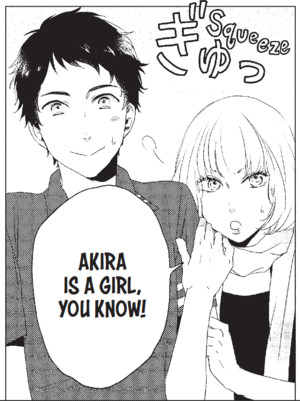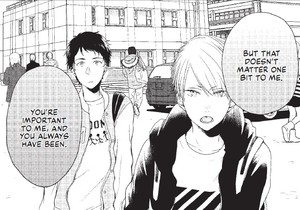The Fall 2024 Manga Guide
Otonari Complex
What's It About?

An endearing manga about childhood best friends--a "girly" boy and a "boyish" girl--working through their feelings about identity and love.
Kuji Akira and Ninomiya Makoto are childhood friends and neighbors. Since Akira is “handsome” for a girl and Makoto is “pretty” for a boy, their gender presentation is often confused. As they try to untangle their complex feelings about themselves and each other, they find out their friends are crushing on them, too. It's a complicated childhood friend love story!
Otonari Complex has a story and art by Saku Nonomura, with English translation by Jenny McKeon. This volume was retouched and lettered by Aidan Clarke. Published by Seven Seas (September 10, 2024).
Is It Worth Reading?

Lauren Orsini
Rating:
For a technically cis heterosexual romance, this manga has some of the queerest vibes I've seen. The starring characters are commonly referred to by others as a “reverse couple,” because they consist of a feminine boy and a boyish girl. That's the “reverse” part down pat, but it's the “couple” portion where things get frustrating. Everyone knows these two are dating except the pair themselves! Since the main couple isn't about to exit this bullheaded stasis, the manga resorts to introducing an ever-growing cast of half-developed ensemble characters to attempt (and fail) to smush their faces together.
Kuji Akira and Ninomiya Makoto are neighbors (that's the otonari from the title) and childhood friends. They're so close that they're often mistaken for boyfriend and girlfriend—but not the way you'd think. With her short hair and preference for butch fashion, Akira is often assumed to be a boy. Meanwhile, Makoto's delicate features and penchant for crossdressing cause strangers to mistake him for a girl. But like good childhood friends, the pair accept one another exactly as they are and would never dream of asking, or even wanting, the other to change. What's more, it's clear that they have a mutual crush on each other—only neither one will make the first move! When Makoto asks Akira how she'd feel if he got a girlfriend, Akira is too dense to realize this is as good as asking her out. As a result, Makoto is resigned to living with an unrequited crush and Akira is even more repressed than that, not even admitting her feelings about Makoto to herself. As the pair get entangled in outside relationships, there's dramatic irony in the way that other people realize Akira and Makoto are in love, even if they don't see it themselves!
Otonari Complex is filled with detailed, delicate art that emphasizes Makoto and Akira's unconventional presentations and highlights their individual charms. As much as I like them, I couldn't care less about most of their friends, who are really just plot devices in high schooler clothing. Despite everyone's efforts, however, there is little progress by the end of the volume. I enjoyed this manga's depiction of two gender-nonconforming people living their best lives, but as a romance, it was unfulfilling and kind of a bust.

Rebecca Silverman
Rating:
Depending on your tolerance for emotionally dense characters in your romance fiction, this is either a book you'll adore or one that'll make you want to beat your head against the wall. Or both, possibly; Otonari Complex is simultaneously one of the cutest and most frustrating books I've read recently. It stars two childhood friends who have been joined at the hip since preschool, and as far as virtually everyone who knows them is concerned, the real mystery is why they aren't officially dating yet. Not that they phrase it quite that way; it's more that they're baffled by how close Akira and Makoto are. The two do very nearly everything together, the ultimate best friends, and the only thing keeping them from being more than that is they're having trouble figuring out that they may actually be in love with each other.
Or rather, Akira is having trouble with that concept. By the middle of the book, when the point of view shifts from her to Makoto, it becomes clear that Makoto has known about his own romantic feelings for a very long time. But Akira isn't ready for that, or even to think about her own emotions, and that feels like it's wrapped up in the fact that people have assumed she's a boy from almost day one. She says she's okay with that, but it's clear that she isn't. Akira has been made to feel insufficiently female to the point where she went to a girls' middle and high school because at least there she got the prince treatment – although that's hardly what she was looking for, either. With Makoto being so attractive as both boy and girl (he cross-dresses sometimes, which he seems to enjoy), Akira may simply feel unworthy, even if she hasn't fully realized that yet.
This volume does make a real attempt to look at the social construct of gender, even if it is sometimes an imperfect one. Makoto notes that he shops differently depending on which gender he's presenting as, and his body language changes a bit too. Akira, meanwhile, is always just herself, and although she's not one hundred percent comfortable with that, she's also more invested in wearing comfortable clothes. She knows who she is and what she likes; she's just not certain that that's acceptable.
Despite its issues, most of which are the way the characters lack a clue or twelve, I really enjoyed this book and I'm definitely going to pick up volume two. The translation is solid without trying too hard, the art is nice, and even if it doesn't always know how to use its themes, it really does have its heart in the right place.

Jean-Karlo Lemus
Rating:
The real fun of a romance manga is stewing in the melodramatic emotions of the protagonist. Why do they take so long to actually spit out their feelings? Because we love seeing messy losers flail around each other. Provided, I wouldn't call Akira or Makoto losers, not unless I wanted to lose some teeth.
There's some good drama in Otanari Complex, and a lot of it revolves around how our leads aren't particularly gender-conforming. Akira has been confused for a man all her life, and Makoto's good looks help him pass convincingly as a woman when he cross-dresses (which he'll do just because he enjoys it). I appreciate the twist on Akira's reluctance to come clean with any kind of confession. Plenty of the other characters can see that Akira and Makoto are likely a lot more than childhood friends, but maybe years of getting looked at as intensely unfeminine have done a number on Akira's self-esteem. Makoto definitely values her and is painfully protective of her, maybe he just wants her to be honest with herself and let herself have something she wants without fretting about other people's feelings.
Otanari Complex is definitely very idealized; at its core, it's a romantic melodrama between childhood friends, and even if some of the assumptions people make about Akira and Makoto can be a little hurtful (mostly Akira's self-esteem and identity as a woman), it's nice that nobody is particularly bigoted over it. Heck, Makoto's cross-dressing is well-known at the local convenience store he visits and the employees think nothing of it. If there's friction, it's interpersonal: Akira and Makoto slowly realize that the way they talk or react to each other isn't quite how they comport themselves around other people. A slow burn? Sure, but the emotions in this romance ring true nevertheless. Strongly recommended.
discuss this in the forum (25 posts) |
back to The Fall 2024 Manga Guide
Seasonal homepage / archives